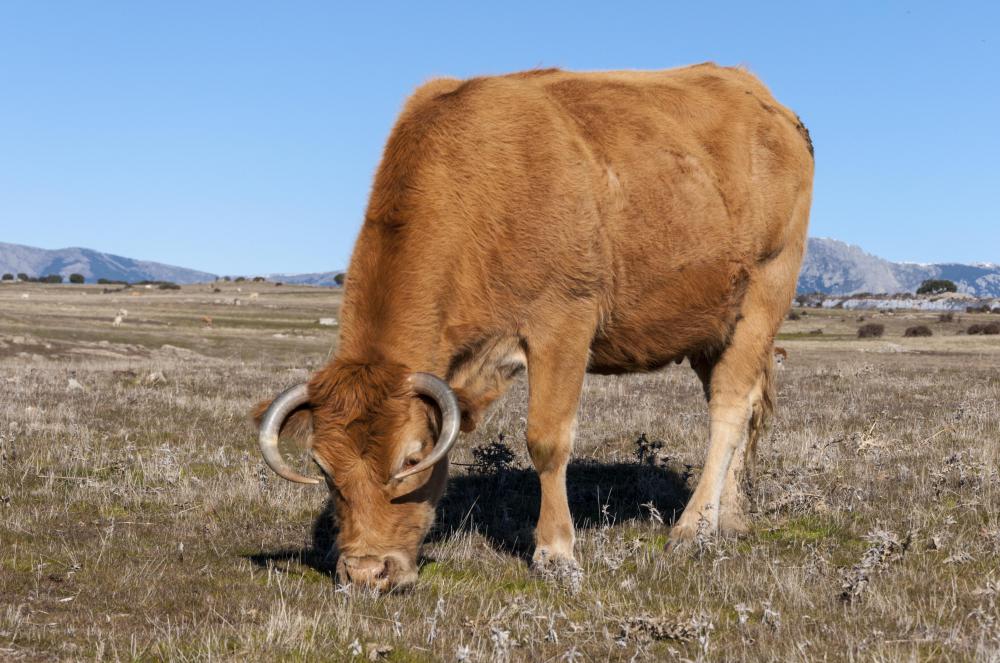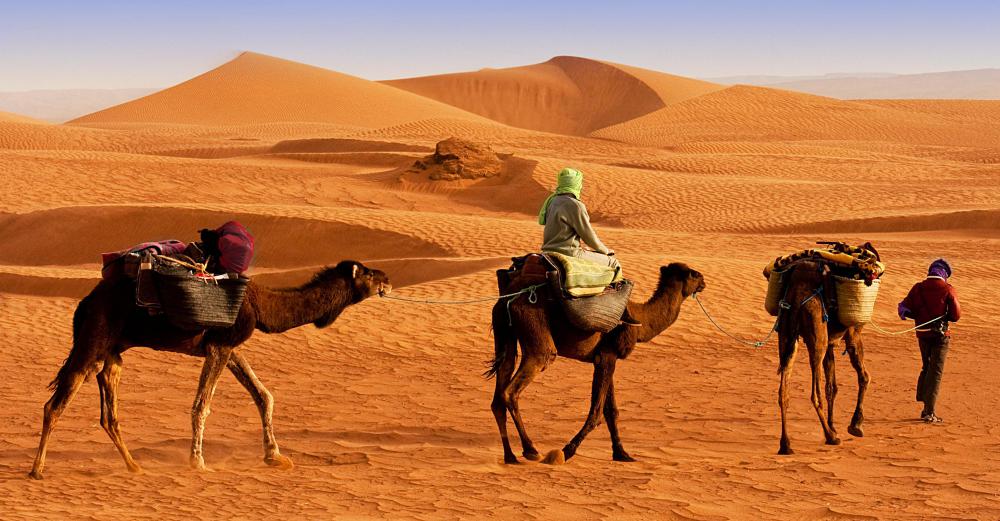At AllThingsNature, we're committed to delivering accurate, trustworthy information. Our expert-authored content is rigorously fact-checked and sourced from credible authorities. Discover how we uphold the highest standards in providing you with reliable knowledge.
What is Livestock?
The word “livestock” is an umbrella term used for domesticated animals raised in an agricultural environment, with the intent of providing food, textiles, labor, or fertilizer to their owners. Common examples are horses, pigs, goats, cows, sheep, and poultry, although numerous other semi-wild animals including reindeer, yaks, camels, and emus could also be considered livestock. Humans have coexisted with domesticated animals for centuries, and the rise of farming and keeping animals probably contributed to a major shift in human culture.
The word can be taken to have several meanings, depending on interpretation. Livestock is sometimes referred to as “stock,” in shorthand, reflecting the idea that the animals are property in addition to living beings. These animals are both living stock, or inventory, and the stock, or basis, of life for farmers and the people who rely on them. Raising animals is an important part of life for people all over the world.

Purely domesticated animals such as cows and horses are radically different than their wild counterparts. In some cases, the wild ancestors of domesticated livestock are actually extinct, because humans have selectively bred domesticated versions for so long. Domesticated livestock would probably have difficulty surviving in the wild, because it has been bred to be smaller and more docile than a wild animal would be. Semi-wild animals used as livestock, such as rabbits, have thriving wild populations in addition to domestic ones.

The uses for livestock are myriad. The most obvious is food, in the form of meat, dairy, and egg products. Few animals, however, are raised purely for their meat; the most notable exception to this is the pig, which is primarily a food animal. Most animals also contribute something else to the farm. Sheep, for example, have thick wool coats which are annually sheared to make textiles, and cows can provide physical labor as draft animals in addition to being a source of food. All livestock also produces plentiful amounts of manure, in the form of excrement, thus helping out in the farm garden as well.

Some of these animals are also kept as pets, and enjoy privileged positions in human society. Horses, for example, are widely ridden and used as work animals, and in many cultures they have a status which borders on the sacred, while others have no difficulties eating their horses. In areas where living conditions are difficult, such as Tibet, a single livestock animal like the yak may provide the bulk of food, shelter, and companionship; therefore, the animals are highly valued.
Frequently Asked Questions
What exactly qualifies as livestock?

Livestock refers to domesticated animals raised in an agricultural setting to produce commodities such as food, fiber, and labor. This category primarily includes cattle, sheep, goats, pigs, and poultry. According to the Food and Agriculture Organization, these animals contribute to the livelihoods of 1.3 billion people globally.
How do livestock contribute to the economy?

Livestock play a pivotal role in the economy by providing meat, dairy, wool, and leather, contributing significantly to global food security and nutrition. The livestock sector represents about 40% of the global value of agricultural output and supports the livelihoods and food security of almost a billion people, as reported by the World Bank.
What are the environmental impacts of raising livestock?

Raising livestock has a substantial environmental footprint, contributing to deforestation, water pollution, and greenhouse gas emissions. Livestock are responsible for 14.5% of all anthropogenic greenhouse gas emissions, as estimated by the Food and Agriculture Organization. Sustainable practices are crucial to mitigate these impacts.
Can livestock farming be sustainable?

Yes, livestock farming can be sustainable with practices like rotational grazing, integrated crop-livestock systems, and precision farming. These methods aim to balance productivity with environmental stewardship. The FAO emphasizes that sustainable livestock farming can improve food security while minimizing resource use and ecological damage.
What role do livestock play in culture and society?

Livestock are deeply embedded in many cultures and societies, serving not just as a food source but also as symbols of wealth, status, and tradition. They are integral to ceremonies, religious practices, and social structures in various communities, reflecting a rich tapestry of human-animal relationships throughout history.
How does livestock farming affect public health?
Livestock farming affects public health through the potential spread of zoonotic diseases, which are diseases that can be transmitted from animals to humans. Proper management and biosecurity measures are essential to prevent outbreaks. Additionally, livestock products are a crucial source of nutrition, providing essential proteins, vitamins, and minerals for human diets.
AS FEATURED ON:
AS FEATURED ON:


















Discussion Comments
I also do livestock, and I really enjoy it because I can employ two to three people in my farm and that can also serve as an income generator for their families, too.
Any time you are going to be away for more than a few hours, you have to figure out how you are going to get the livestock fed.
We have some neighbors who only live on a few acres, but they have chickens, goats, emus and honeybees. They rely on family members to help them if they are going to be away.
I would not want all this responsibility, but I do enjoy buying fresh eggs from them. These are brown eggs that have bright yellow yolks and thick shells.
I know these are free-range chickens, because they make it down to my place every now and then!
I found a man who raises his own livestock and sells the organic meat. I pay for the meat and for the processing fee, but when I buy a large amount at a time, it ends up being way cheaper than I could buy in the store.
You can really tell a difference in the quality of meat when the livestock has been raised organically.
I have a big freezer to keep this in, and usually order from him once every 6 months. In addition to his organic livestock, he has organic vegetables that his wife grows in her garden.
I am thankful I found a source to buy some healthy, organic food without paying such a high price for it.
If you pull up to one of their country stores, you will usually always see several horses tied up at the fence.
It is also not uncommon to see them transporting people from place to place pulling them in a buggy.
If you aren't around this very often, it really seems like a novelty, but there are many groups of people who still use their livestock this way.
You also see many hog farms and horses in every corner of the state. For many people where I live, the livestock industry is a major portion of their income.
If you ever come to our state fair, the livestock that the kids show for their 4-H projects is always a big attraction. Growing up around the noise and smell of different livestock is a normal part of life for us.
I know a guy who lives down the road and raises sheep strictly for their wool. He has a large herd of livestock and two Great Pyrenees dogs to serve as shepherds.
Those sheep are fluffy and white during parts of the year and nearly bald during others. The sheep dogs are equally white, and they blend in so well that you don't notice that they are dogs until they begin to chase you. They chase cars that drive by, thinking that they are protecting the sheep from them.
I know that in the days of old, people had to tend to the sheep to keep them from wandering off and being eaten by wolves. Today, most sheep are kept in pens, and special dogs keep the coyotes away.
My neighbor raises chickens for food, and I used to be terrified of them when I was a kid. I often went over there to play with a girl my age, and one time, she took me into the chicken pen.
The hens were okay, because they just clucked and darted here and there. The rooster was the bully. He had sharp claws, and my friend had warned me that if he gave chase, we should run to the barn loft.
He angrily began chasing us, so we climbed up into the hay-filled loft. This seemed to satisfy the rooster.
After that experience, any qualms I had about eating cute little chickens went away. I felt no guilt while munching on a fried chicken sandwich.
Every person I have met with a herd of cattle in my lifetime just uses them to make money. They don't do any slaughtering or milking themselves. They just sell them at an auction to the highest bidder, who then will see to the unpleasant tasks of using the cattle.
It makes me a little sad to see a clueless herd of cows happily grazing in a field. They have no idea that they are just there to be fattened up and murdered.
The cows provided the three M's – milk, meat, and manure. Pigs and chickens provided breakfast, lunch, and dinner. Chickens were really useful, because you could use them to make various soups, meals of fried chicken, and scrambled eggs for breakfast.
The cow manure really helped out in the vegetable garden. My grandparents told me that they produced large, juicy tomatoes and bountiful corn because of the fertilizer.
you mention nothing of the environmental impacts attributed to raising livestock.
Post your comments